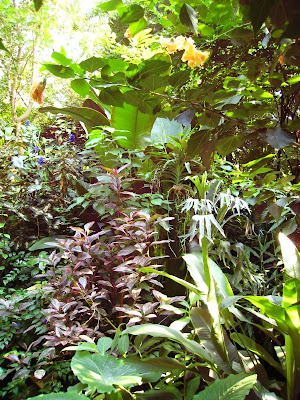By guest garden writer: Helen YoestPrior to going to Portland, Oregon and meeting writer and stylist
Debra Prinzing and photographer William Wright, I read their book,
Stylish Sheds and Elegant Hideaways.

It was a gift from my friend James Baggett, Editor of
Country Gardens magazine. He knew I liked garden books in general, but James also knew I like places to go in the garden – destinations such as seating areas, potting benches, gazebos, porches, sheds, hideaways.
With the tempting title waiting, I poured a fresh cup of coffee, with just the right amount of cream and began to read. Inspiration sprung, fantasy flourished. It was a great way to spend a morning.
For a very long time now, I’ve wanted to add a greenhouse, but not just any greenhouse. I always fancied it would have a certain look; a place where I could put not only plants, but a single chair and small table so I could go there to take my afternoon tea.

The location of the greenhouse, I thought, would have to be relegated to the “service” area of my garden – next to the shed. My shed is strictly utilitarian. We don’t have a garage to store bikes, garden tools, the mower, and other objects necessary to function as an all American family. I always assumed the greenhouse would go right next to the shed. Currently, there’s a table there and I refer to this area as the holding area. Calling it a nursery, would be too important of a word for the purpose. This place holds plants until I have a place to put them.
I’ve wanted a greenhouse to hold over tender plants - but I really wanted it as place for an escape. The idea of having a place of my own in the garden, protected from elements was the dream. Using it to hold over tender plants was the justification.
I just couldn’t get excited about the space though. It wasn’t enough to have a place to go. I needed it to be in a place I wanted to go. I was looking for a destination, one that wasn't closed off. I also couldn't see the garden from the service area. And that is exactly what that space would have done.

After reading Debra’s book, I had an epiphany. If the building is beautiful and well sited, then I could move it out of the service area and make it a part of the garden. Once I realized this, I began to take the steps to make this dream a reality.
I found my perfect greenhouse. It is offered by
Smith & Hawken. I give monthly seminars there, so I’m familiar with their products. I love the look and after having looked around for a long time, I knew I would know it when I saw it. The Smith & Hawken greenhouse meets not only my need for aesthetics, but for function as well.
Debra and William's book touches nicely on the spaces featured including the bits of information about the owners and how they made their space personal. Each featured space has a chart to show the process the owners went through to create their space including the mission, must-haves, inspiration, design challenges, creative solutions.
For kicks and grins, I thought I would write my
design statement. Put it on paper, so I could visualize it, make it real, make it my own.
The styling and photography are phenomenal. As a stylist, I can see all the attention to detail that happened to make these photographs what they are. And William caught the light just right. Well done!

All photo credits
William Wright Photography.
About today's author: Helen Yoest is a gardener, garden writer and a garden coach. Helen writes for Metro Magazine, Fine Gardening Magazine, Carolina Gardener, Nature's Garden, and is also a field editor for Better Homes and Gardens and their special publications. As a volunteer, Helen is a passionate promoter of area gardeners and gardens and has the honor of sitting on the Board of Advisors of the JC Raulston Arboretum. She is also the area representative for the Garden Conservancy Open Days tour. Contact Helen through her website GardensGardens.
All company or product or patented names mentioned are registered trademarks/copyrights/patents owned by those respective companies or persons.
 My deer friends are a common sight lately. We often have to walk out into the front meadow to encourage a herd of deer to move on. One fawn seems to think about trying to play with our greyhound--not an activity that we wish to see.
My deer friends are a common sight lately. We often have to walk out into the front meadow to encourage a herd of deer to move on. One fawn seems to think about trying to play with our greyhound--not an activity that we wish to see. 



























































